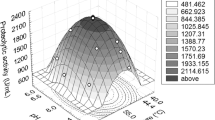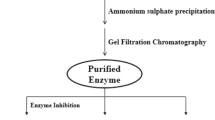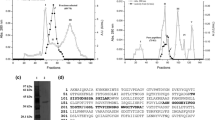Abstract
Penicillium nalgiovense PNA9 produces an extracellular protease during fermentation with characteristics of growth-associated product. Enzyme purification involved ammonium sulfate precipitation, dialysis, and ultrafiltration, resulting in 12.1-fold increase of specific activity (19.5 U/mg). The protein was isolated through a series of BN-PAGE and native PAGE runs. ESI-MS analysis confirmed the molecular mass of 45.2 kDa. N-Terminal sequencing (MGFLKLLKGSLATLAVVNAGKLLTANDGDE) revealed 93 % similarity to a Penicillium chrysogenum protease, identified as major allergen. The protease exhibits simple Michaelis-Menten kinetics and K m (1.152 mg/ml), V max (0.827 mg/ml/min), and k cat (3.2 × 102) (1/s) values against azocasein show that it possesses high substrate affinity and catalytic efficiency. The protease is active within 10–45 °C, pH 4.0–10.0, and 0–3 M NaCl, while maximum activity was observed at 35 °C, pH 8.0, and 0.25 M NaCl. It is active against the muscle proteins actin and myosin and inactive against myoglobin. It is highly stable in the presence of non-ionic surfactants, hydrogen peroxide, BTNB, and EDTA. Activity was inhibited by SDS, Mn2+ and Zn2+, and by the serine protease inhibitor PMSF, indicating the serine protease nature of the enzyme. These properties make the novel protease a suitable candidate enzyme in meat ripening and other biotechnological applications.







Similar content being viewed by others
References
Matsusima, K. I., Hayakawa, M., Ito, M., & Shimada, K. (1981). Features of the proteolytic enzymes system of hyper-acid-productive and non-acid-productive fungi. The Journal of General and Applied Microbiology, 27, 423–426.
Graminho, E. R., da Silva, R. R., de Freitas Cabral, T. P., Arantes, E. C., et al. (2013). Purification, characterization, and specificity determination of a new serine protease secreted by Penicillium waksmanii. Applied Biochemistry and Biotechnology, 169, 201–214.
Benito, M. J., Rodríquez, M., Núnez, F., Asensio, M. A., Bermúdez, M. E., & Córdoba, J. J. (2002). Purification and characterization of an extracellular protease from Penicillium chrysogenum Pg222 active against meat proteins. Applied and Environmental Microbiology, 68, 3532–3536.
Zhu, H. Y., Tian, Y., Hou, Y. H., & Wang, T. H. (2009). Purification and characterization of the cold-active alkaline protease from marine cold-adaptive Penicillium chrysogenum FS010. Molecular Biology Reports, 36, 2169–2174.
Abbas, C. A., Groves, S., & Gander, J. E. (1989). Isolation, purification, and properties of Penicillium charlesii alkaline protease. Journal of Bacteriology, 171, 5630–5637.
Yamamoto, N., Matsumoto, K., Yamagata, Y., Hirano, K., & Ichisima, E. (1993). A heat-labile serine protease from Penicillium citrinum. Phytochemistry, 2, 1393–1397.
Singh, K., & Martin, S. M. (1960). Purification and properties of a protease from Penicillium cyaneo-fulvum. Canadian Journal of Biochemistry and Physiology, 38, 969–980.
Day, J., Koszelak, S., Cascio, D., & McPherson, A. (1986). Isolation, characterization and preliminary x-ray diffraction data for a serine protease from Penicillium cyclopium. The Journal of Biological Chemistry, 261, 1957–1961.
Papagianni, M., Ambrosiadis, J., & Filiousis, G. (2007). Mould growth on traditional Greek sausages and penicillin production by Penicillium isolates. Meat Science, 76, 653–657.
Andersen, S. J. (1995). Taxonomy of Penicillum nalgiovense isolates from mould-fermented sausages. Antonie Van Leeuwenhoek, 68, 165–171.
Ludemann, V., Pose, G., Pollio, M. L., & Segura, J. (2004). Determination of growth characteristics and lipolytic and proteolytic activities of Penicillium strains isolated from Argentinian salami. International Journal of Food Microbiology, 96, 13–18.
Toledo, V. M., Selgas, M. D., & Garcia, M. L. (1997). Effect of selected mould strains on proteolysis in dry fermented sausages. Zeitschrift für Lebensmittel-Untersuchung und -Forschung A., 204, 385–390.
Samson, R. A., Hoekstra, B. S., Frisvad, J. C., & Filtenborg, O. (1995). Introduction to food-borne fungi. Baarn, The Netherlands: Centralbureau voor Schimmercultures.
Iversen, S. L., & Jørgensen, M. H. (1995). Azocasein assay for alkaline protease in complex fermentation broth. Biotechnology Techniques, 9, 573–576.
Schägger, H. (2003). SDS electrophoresis techniques, in Membrane protein purification and crystallization. In C. Hunter, G. von Jagow, & H. Schägger (Eds.), A practical guide (2nd ed., pp. 4.85–4.103). San Diego: Academic.
Wittig, I., Braun, H. P., & Schägger, H. (2006). Blue native PAGE. Nature Protocols, 1, 418–428.
Bradford, M. (1976). A rapid and sensitive method for the quantification of microgram quantities of protein utilizing the principle of protein dye binding. Analytical Biochemistry, 72, 248–254.
Cohen, S. L., & Chait, B. T. (1997). Mass spectrometry of whole proteins eluted from sodium dodecyl sulphate-polyacrylamide gel electrophoresis gels. Annals Biochemistry, 247, 257–267.
Mirza, U. A., Chait, B. T., & Lander, H. M. (1995). Monitoring reactions of nitric-oxide with peptides and proteins by electrospray-ionization mass-spectrometry. The Journal of Biological Chemistry, 270, 17185–17188.
Komatsu, S. (2009). Western blotting /Edman sequencing using PVDF membrane. Methods in Molecular Biology, 536, 163–171.
Reichard, U., Buttner, S., Eifferst, H., Staib, F., & Ruchel, R. (1990). Purification and characterisation of an extracellular serine proteinase from Aspergillus fumigatus and its detection in tissue. Journal of Medical Microbiology, 33, 243–251.
McIntyre, M., Berry, D. R., & McNeil, B. (2000). Role of protease in autolysis of Penicillium chrysogenum chemostat cultures in response to nutrient depletion. Applied Microbiology and Biotechnology, 53, 235–242.
Papagianni, M., Wayman, F., & Mattey, M. (2005). Fate and role of ammonium ions during fermentation of citric acid by Aspergillus niger. Applied and Environmental Microbiology, 71, 7178–7186.
Lasure, L. L. (1980). Regulation of extracellular acid protease in Mucor miehei. Mycologia, 72, 483–493.
Paterson, I. C., Charney, A. K., Cooper, R. M., & Clarkson, J. M. (1994). Partial characterization of specific inducers of a cuticle-degrading protease from the insect pathogenic fungus Metarhizium anisopliae. Microbiology, 140, 3153–3159.
Benito, M. J., Connerton, I. F., & Córdoba, J. J. (2006). Genetic characterization and expression of the novel fungal protease, EPg222 active in dry-cured meat products. Applied Microbiology and Biotechnology, 73, 356–365.
Chakrabarti, S. K., Matsumura, N. A., & Ranu, R. S. (2000). Purification and characterization of an extracellular alkaline serine protease from Aspergillus terreus (IJRA 6.2). Current Microbiology, 40, 239–244.
Hajji, M., Kanoun, S., Nasri, M., & Gharsallah, N. (2007). Purification and characterization of an alkaline serine protease from Aspergillus clavatus ES1. Process Biochemistry, 42, 791–797.
Impoolsup, A., Bhumiratana, A., & Flegel, T. (1981). Isolation of alkaline and neutral proteases from Aspergillus flavus var. columnaris, a soy sauce koji mold. Applied and Environmental Microbiology, 42, 619–628.
Pekkarinen, A. I., Jones, B. L., & Niku-Paavola, M. L. (2002). Purification and properties of an alkaline protease of Fusarium culmorum. European Journal of Biochemistry, 269, 798–807.
Klingeberg, M., Galunski, B., Sjohom, C., Kasche, V., & Antranikian, G. (1995). Purification and properties of a highly thermostable, sodium dodecyl sulfate-resistant and stereospecific protease from the extremely thermophilic archaeon Thermococcus stetteri. Applied and Environmental Microbiology, 61, 3098–3104.
Morya, Y. K., Yaday, S., Kim, E. K., & Yaday, D. (2012). In silico characterization of alkaline proteases from different species of Aspergillus. Applied Biochemistry and Biotechnology, 166, 243–257.
UNIPROT: http://www.uniprot.org (Protein Knowledge Base, UniProtKB)
Chu, H., Lai, H. Y., Tam, M. F., Chou, M. Y., Wang, S. R., Han, S. H., & Shen, H. D. (2002). cDNA cloning, biological and immunological characterization of the alkaline serine protease major allergen from Penicillium chrysogenum. International Archives. Allergy and Immunology, 17, 15–26.
Karolewiez, A., & Geisen, R. (2005). Cloning a part of the ochratoxin A biosynthetic gene cluster of Penicillium nordicum and characterization of the ochratoxin polyketide synthase gene. Systems Applied Microbiology, 28, 588–595.
Chiu, L. L., Lee, K. L., Lin, Y. F., Chu, C. Y., Su, S. N., & Chow, L. P. (2008). Secretome analysis of novel IgE-binding proteins from Penicillium citrinum. Proteomics Clinical Applied, 2, 33–45.
Toldrá, F., Cerveró, C., Rico, E., & Part, C. (1993). Porcine aminopeptidase activity as affected by curing agents. Journal of Food Science, 58, 724–726.
Beg, Q. K., & Gupta, R. (2003). Purification and characterization of an oxidation stable, thiol-dependent serine alkaline protease from Bacillus mojavensis. Enzyme Microbiology Technology, 32, 294–304.
Doddapaneni, K. K., Tatinenin, R., Vellanki, R. N., Gandu, B., Panyala, N. R., Chakali, B., & Mangamoori, L. M. (2007). Purification and characterization of two novel extracellular proteases from Serratia rubidaea. Process Biochemistry, 42, 1229–1236.
Acknowledgments
The authors would like to thank Prof. E.M. Papamichael from the Department of Chemistry, University of Ioannina for his helpful suggestions regarding the methodologies followed in this work.
Author information
Authors and Affiliations
Corresponding author
Rights and permissions
About this article
Cite this article
Papagianni, M., Sergelidis, D. Purification and Biochemical Characterization of a Novel Alkaline Protease Produced by Penicillium nalgiovense . Appl Biochem Biotechnol 172, 3926–3938 (2014). https://doi.org/10.1007/s12010-014-0824-3
Received:
Accepted:
Published:
Issue Date:
DOI: https://doi.org/10.1007/s12010-014-0824-3




